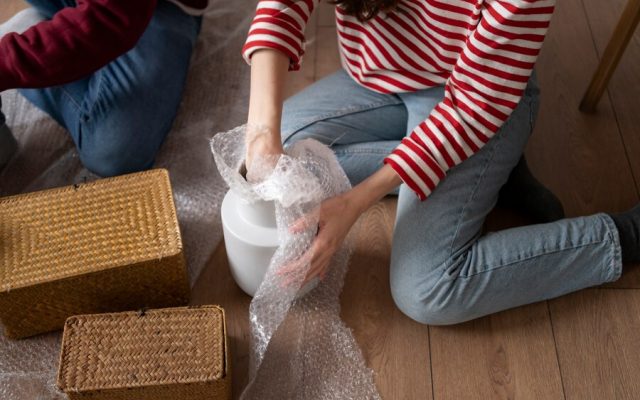How to Pack Clothes for Moving

Moving to a new place is an exciting chapter in life, but packing up your belongings can be daunting. Among the numerous items that need careful attention, clothes stand out as both essential and potentially challenging to pack efficiently.
Let’s explore the art of packing clothes for a move, focusing on strategies to ensure your garments arrive at your new destination in the best condition possible.
Things to Do Before Packing
Delve into your collection of clothes, taking a deliberate moment to consider each item’s relevance. In this introspective process, contemplate the garments that have faithfully accompanied you through various chapters of your life. Yet, as you reflect, also recognize the clothes that have quietly faded into the background, their purpose and charm now overshadowed by time.
Embrace the liberating act of letting go – a ritual where you donate, sell, or even discard items that no longer resonate with your style or serve a practical purpose. This curation process is more than just a prelude to packing; it’s an act of mindful transition. As you bid your farewell to these garments, you create room in your suitcase and your life, making space for new experiences and fresh memories in your new house.
Choosing the Right Clothing Packing Method
When it comes to packing your clothes, there are various methods to choose from. One effective approach is to categorize your clothing by type, season, or material. This will make unpacking at your new home much more convenient.
- Protect delicate fabrics. Envelope these clothes in tissue paper or wrap them in garment bags, ensuring their passage through the shifting landscapes of packing and unpacking remains unblemished.
- Use your socks and smaller pieces of clothing as space-maximizing tools. Nestled within the crevices of your boxes, they play a vital role in preserving the integrity of your more delicate possessions.
You can also label your clothing boxes by season ‒ it’s a convenient way to prioritize what to unpack first when you arrive at your new home.
Best Way to Pack Non-Hanging Clothes
For non-hanging clothes like t-shirts, jeans, and sweaters, the key is efficient folding. Lay each garment flat and fold them neatly to minimize wrinkles. Stack similar items together to create compact bundles that can be easily arranged in boxes.

The aim is practicality – folding methodically to make the most of the available space and keep your clothes as wrinkle-free as possible. Group similar items together, creating compact bundles that can be easily accommodated within boxes. This systematic approach ensures that your clothes remain organized and ready for use once you reach your new destination.
Best Way to Pack Hanging Clothes
Hanging clothes can be a bit trickier, but there’s a simple solution. Invest in wardrobe boxes, which are designed to keep your clothes on hangers during the move. This prevents wrinkles and allows for easy transfer from your old closet to the new one.
These boxes act like portable closets, ensuring that your clothes remain on hangers throughout the journey. With wardrobe boxes, you can maintain the organized state of your hanging clothes, making unpacking and resettling much smoother when you reach your destination.
How to Fold Clothes For Packing
Mastering the art of folding clothes is a fundamental skill that significantly contributes to efficient packing. The process begins by tending to the larger items in your wardrobe, such as pants and skirts. To do this, fold them in half lengthwise, then proceed to fold them again into thirds. This technique not only reduces the space they occupy but also minimizes the chances of wrinkles settling in.
When it comes to shirts and blouses, a methodical approach yields satisfying results. Begin by gently folding the arms inward, aligning them with the garment’s sides. This initial fold lays the foundation for the subsequent steps. With the arms neatly in place, proceed to fold the entire garment into a rectangle. This compact, symmetrical shape is not just space-efficient but also adept at preserving the fabric’s crispness.
Throughout this process, the objective remains consistent: to create stacks of clothes that are both compact and effortlessly stackable.
How to Pack Shoes
Safely packing your shoes is a task that demands a blend of care and foresight. Before they find their place within the confines of moving boxes, it’s advisable to grant them a moment of attention. Begin by thoroughly cleaning and allowing them to air out, ensuring that any remnants of the journeys they’ve taken are left behind. This preliminary step not only maintains the hygiene of your footwear but also prevents any unwanted odors from mingling with your other belongings during the move.
With your shoes in their best possible condition, the next step involves protection. Shielding them from potential scuffs and abrasions is a simple yet crucial endeavor. This involves individually placing each pair within a plastic bag – a barrier that safeguards their surfaces from unwanted contact. By doing so, you effectively preserve their aesthetic appeal, allowing them to emerge from their temporary hibernation unscathed.
As you arrange these safeguarded shoes within your moving boxes, an opportunity presents itself. Empty spaces, those interstitial pockets within the boxes, can be utilized with a strategic touch. These crevices, often overlooked, become the perfect abode for socks or small clothing items. This dual-purpose strategy optimizes the utilization of space while offering an additional layer of protection to your shoes.
Best Tips on How to Pack Clothes for Moving
We couldn’t let you finish this article without these additional packing tips that will make your packing experience more tolerable.
- Rolling clothes is an alternative method that can save space and reduce wrinkles. Experiment with rolling items like t-shirts and lightweight garments.
- Make use of your suitcases to pack clothes. They are easy to transport and provide additional protection for your garments.
- Small ziploc bags are handy for organizing accessories, socks, and undergarments. They keep these items together and prevent them from getting tangled or lost in the shuffle.
- Begin by packing clothes that are out of season. This helps you prioritize the items you won’t need immediately and ensures that you’re packing only the essentials for your current season.
- For delicate fabrics, consider wrapping them in tissue paper or placing them in garment bags to prevent snagging and damage.
- Pack complete outfits together to streamline your unpacking process. This way, you won’t need to rummage through boxes to find matching items when you’re settling into your new home.
- Utilize the space inside soft items like duffel bags, backpacks, and tote bags. Fill them with clothes, linens, or even shoes to make the most of every available inch and reduce the number of boxes needed.
- Clearly label each box with its contents and the room it belongs to. This will make unpacking a breeze.

Packing clothes for a move requires a combination of organization, careful folding, and strategic planning. By following these methods, you can ensure that your clothes remain in excellent condition during the transition.
Remember, taking the time to pack your clothes thoughtfully will pay off when you arrive at your new home with a wardrobe that’s ready to be effortlessly integrated into your new life.
How useful was this post?
Click on a star to rate it!
Average rating 0 / 5. Vote count: 0
No votes so far! Be the first to rate this post.





